Tuesday, 01/Oct/2019
The state of UX

Photo by David Travis ⇥ on Unsplash
I was reading an insightful article by Max Taylor on how the discipline of user experience is perceived today in the industry, and I have to say, I couldn't agree more.
Countless times through out my career I have been asked to research, formulate solutions and design for users, but with quite narrow a scope. We unavoidably ended up with well designed solutions to quite specific problems which did not cover the entire user experience. Every single time.
Ignoring the big picture
To give a small and simple example, think of a digital money transfer process. Or better yet, think of the best digital money transfer process of your favorite bank or e-commerce site/app. Now try to think how different the experience of performing this task feels under different scenarios: standing in a crowded bus, holding bags/groceries/coffee cup with your hands, holding a baby in your arms, navigating a busy side walk, walking with the help of a cane. The experience of transferring money in these situations will feel quite different as you will feel different under each scenario. Stressed, uncomfortable, rushed. Any and more emotional states could apply. In fact the two things these experiences have in common is that transferring money is not the primary task being performed, and the emotional state of the user can wildly vary.
So why is it most UX work done does not take into account external factors to the experience? Why is it UX designers assume that the products or services they are designing for will be used in a quiet environment, safe from distractions? This approach reminds me of science experiments performed in lab conditions versus the wild, sure enough an important step but certainly not the final one.
Convincing involved stakeholders of the need to expand the experience scope is not an easy feat.
More often than not project, product, or service managers and owners do not fully understand what the UX discipline covers and tend to narrow it down to a specific segment of the experience - usually interaction design.
In such cases, it is up to the designer to educate her/his colleagues and communicate the benefits of a holistic experience design approach.
An experience is as good as its worst designed edge case.